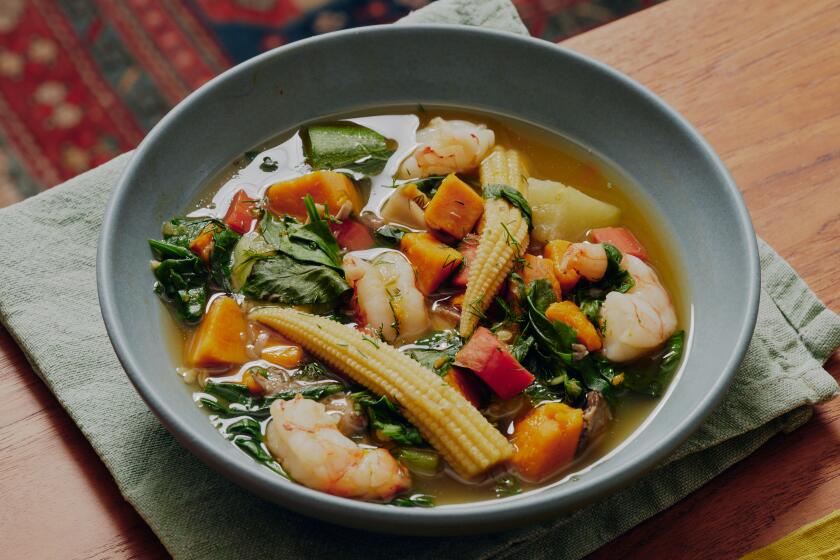Halibut with grapefruit and blood orange sauce
Hanging around on trees all about California: grapefruits -- heavy with juice, tartly sweet, beguilingly perfumed. Round and yellow as happy faces or suns, they seem to ripen just as the general populace sinks into its annual round of post-holiday dietary self-chastisement.
Coincidence? Perhaps. But we say run with it.
Look beyond the obvious salvo of half a grapefruit for breakfast attacked with a jagged spoon and you’ll find a marvelous fruit for peeling and eating out of hand. There’s nothing like it for inducing simultaneous feelings of gastronomic piety and delight at recapturing a long-lost pleasure. It’s sensual: the aroma of essential oils as they spurt daintily from the pores of the thick skin, the ripping sound of the tenacious segments being pulled apart, the juice dripping down. And it’s delicious.
But don’t stop there. Cook with grapefruit. Use its juice to flavor sauces. Section and scatter it. Bake with it. Candy its peel. Grapefruit is milder and sweeter than lemon, but it can be used in many of the same ways -- squeezed on grilled fish, made into a brightly flavored curd. And if you’re looking for gorgeous color, red grapefruit offers extra plate appeal.
The notion that red grapefruit is sweeter than white or yellow grapefruit is, however, a myth, according to citrus specialists. (The story grew out of a marketing campaign by Texas growers.) Red grapefruits get their color from lycopene, which has health benefits (it’s an antioxidant) but does not affect flavor.
Sweetness is determined, rather, by the length of time the fruit has been hanging on a tree. A grapefruit picked in December isn’t as sweet as one picked in February, so if you have a tree, just pick fruit as needed.
If not, ask at your farmers market about the different varieties available, all of which have their fans. California reds include the medium-pink Rio Reds from the Coachella Valley and the Star Ruby from the Central Valley (and Texas). Yellow Marsh is a familiar yellow variety and the Duncan, while not usually labeled as such in supermarkets, is a reliable white.
For those who don’t like the tartness of a true grapefruit, Oro Blanco -- the half-grapefruit, half-acidless pummelo -- is sweeter and can be used in salads.
Our salad of jicama strips, thinly sliced snow peas, fresh pea sprouts (available in Asian markets) and red grapefruit sections has an appealing crunch. Its delicately harmonious flavors are pulled together with a faintly sweet dressing of grapefruit juice, tarragon and mint.
The strikingly pink sauce of our baked halibut dish contrasts with the white flesh of the fish for an artful plate -- and it’s easy to make. Before baking, marinate the halibut in grapefruit juice with garlic and thyme. Sauce it with a reduction of grapefruit juice combined with blood orange juice, which deepens the color and softens the flavor. Then whisk in bits of cold butter for silkiness.
A rich crust is a perfect foil for the tangy grapefruit curd filling in our pretty tartlets. Both grapefruit juice and lemon juice are used in the curd to focus the flavor; grapefruit zest enlivens the crust. Garnish them with whipped cream and candied grapefruit peel.
For cooking, select heavy fruit, which indicates juiciness. (If you’re making a batch of candied peel, however, lighter fruit will indicate more peel.) Before juicing, roll a grapefruit under your hand on the countertop to help extract the most juice. Avoid lumpy fruit, which may be over-ripe.
And finally, for those whose resolute January superegos care about such things, here’s a reassuring thought: Grapefruit is low in calories (40 to 60 each), high in vitamins C and A, and an excellent source of fiber. It contains no fat, sodium or cholesterol.
So peel away.
Rinse the halibut steaks under running water and pat them dry with paper towels. Set the fish aside.
Combine the olive oil, one-half cup grapefruit juice, thyme and garlic. Add salt and pepper to taste. Pour the mixture over the fish in a shallow glass dish. Cover and let the fish marinate 15 minutes.
Put the fish in a lightly buttered baking dish. Dot the top of the fish with 1 1/2 teaspoons butter. Bake in a 400-degree oven, basting once or twice with butter and pan juices, until the fish tests done, about 15 minutes.
While the fish is cooking, prepare the sauce. Heat 1 1/2 teaspoons of the butter in a small saucepan until melted. Stir in the minced shallot and sweat over low heat just until tender, about 1 minute. Stir in the remaining one-half cup grapefruit juice and blood orange juice and bring to a boil.
Reduce heat to a simmer and cook until the juice is reduced to one-third cup, about 20 minutes. Whisk the remaining cold butter into the sauce bit by bit until the sauce thickens slightly. Stir in the salt and pepper to taste.
When the fish is done, remove it from the oven and place it on serving plates. Sprinkle lightly with salt. Spoon the grapefruit sauce over and garnish with a sprinkle of chives.
Get our Cooking newsletter.
Your roundup of inspiring recipes and kitchen tricks.
You may occasionally receive promotional content from the Los Angeles Times.















